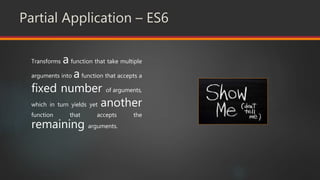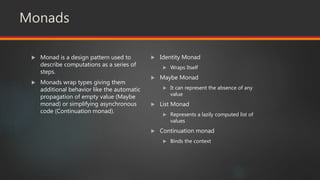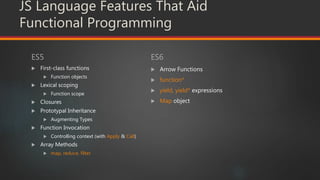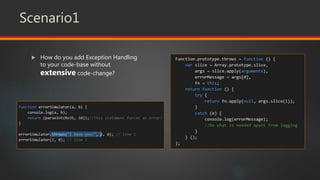Fuel Up JavaScript with Functional Programming
- 2. About Me A passionate programmer finding my way around Functional Programming… Work at UST Global I occasionally blog at http://stoi.wordpress.com Author of YieldJS & SlangJS I recently co-authored a book with my colleague, friend and mentor called “.NET Design Patterns” by PACKT Publishing
- 4. Leap ( A projectile at 90 degrees) Computing Paradigm <Functional> Imperative Paradigms with OOP Domain Driven Design Design Patterns Object Functional Reactive Programming <Functional> Reactive Computing Platform Single Core Multi-core Many-core Clusters/Load-Balancers Hypervisors Virtual Machines Cloud 100 Years
- 5. JS Evolution (A snap-shot) Client Side DHTML/Dom Manipulation XMLHTTP/AJAX jQuery (John Resig) Web Frameworks YUI, JQuery UI, Backbone, Knockout, Angular, Bootstrap etc. Libraries RxJs, Underscore, Prototype, Immutable, Redux, Lodash, Ramda etc. Trans-compilers Coffescript, Typescript, Flow etc. Mobile Application Platforms Hybrid – Sencha/Cordova based Server Side Node.js (Ryan Dahl) Node Modules JS Libraries
- 6. Being Functional Algorithm composition to be dealt on the same lines as mathematical function evaluations Referential Transparency Predictable Transparent Declarative Composable Modular
- 7. Lambda (λ) calculus Alonzo Church Definition Lambda calculus (also written as λ-calculus) is a formal system in mathematical logic for expressing computation based on function abstraction and application using variable binding and substitution var AddOperation = (x, y) => x + y; Lambda Abstraction : λx.x+y [f(x,y) = x + y] Variables : x & y Lambda Term : x + y Simplifications 1. Anonymous functions 2. Uses functions of a single input
- 8. Lambda (λ) calculus - Continued The following three rules give an inductive definition that can be applied to build all syntactically valid lambda terms: A variable x, is itself a valid lambda term If t is a lambda term, and x is a variable, then (λx.t) is a lambda term (called a lambda abstraction); if t and s are lambda terms, then (ts) is a lambda term (called an application)
- 9. Lambda (λ) calculus - Consequences λ Referential Transparency Anonymous Functions First-Class Functions Higher-Order Functions Closures Currying & Partial Application Recursion Memoization
- 10. Referential Transparency Code Motivation Now since state of i is not guaranteed mutation-free AddOneRO (x) <> AddOneRO (y) if x = y, this further implies AddOneRO (x) - AddOneRO (x) <> 0 thus invalidating the fundamental mathematical identity x – x = 0
- 11. Closures Code Motivation Now since state of i is not guaranteed mutation-free AddOneRO (x) <> AddOneRO (y) if x = y, this further implies AddOneRO (x) - AddOneRO (x) <> 0 thus invalidating the fundamental mathematical identity x – x = 0
- 12. Currying Concept Transforms a function that takes multiple arguments into a chain of functions each with a singleargument. a f (a,b,c) a b c
- 13. Currying Implementation – ES5 Augmenting Types Closures Apply Invocation
- 14. Currying Implementation – ES6 Closures Apply Invocation
- 15. Partial Application – ES6 Transforms a function that take multiple arguments into afunction that accepts a fixed number of arguments, which in turn yields yet another function that accepts the remaining arguments.
- 16. Recursion Recursions are leveraged in functional programming to accomplish iteration/looping. Recursive functions invoke themselves, performing an operation repeatedly till the base case is reached Recursion typically involves adding stack frames to the call stack, thus growing the stack You can run out of stack space during deep recursions
- 17. Tail-Call Optimization In this case, no state, except for the calling function's address, needs to be saved either on the stack or on the heap Call stack frame for fIterator is reused for storage of the intermediate results. Another thing to note is the addition of an accumulator argument (product in this case)
- 18. Monads Monad is a design pattern used to describe computations as a series of steps. Monads wrap types giving them additional behavior like the automatic propagation of empty value (Maybe monad) or simplifying asynchronous code (Continuation monad). Identity Monad Wraps Itself Maybe Monad It can represent the absence of any value List Monad Represents a lazily computed list of values Continuation monad Binds the context
- 19. JS Language Features That Aid Functional Programming ES5 First-class functions Function objects Lexical scoping Function scope Closures Prototypal Inheritance Augmenting Types Function Invocation Controlling context (with Apply & Call) Array Methods map, reduce, filter ES6 Arrow Functions function* yield, yield* expressions Map object
- 20. Scenario1 How do you add Exception Handling to your code-base without extensive code-change?
- 21. Scenario2 You tend to write algorithms that operate more often on a sequence of items than on a single item. More likely, you’ll perform several transformations between the source collection and the ultimate result.
- 22. Scenario2 – Solution A Iterating the collection once for every transformation (n iterations for n transformations) Increases the execution time for algorithms with many transformations Increases the application’s memory footprint as it creates interim collections for very transformation END Output List -> Interim List2 Transformation2 (Square) Interim List2 -> [1, 9, 25] Transformation1 (Filter Odds) Interim List1 -> [1, 3, 5] START Input List -> [1, 2, 3, 4, 5]
- 23. Scenario2 – Solution B Create one method that processes every transformation (1 iteration for n transformations) Final Collection is produced in one iteration. This improves performance Lowers the application’s memory footprint as it doesn’t create interim collections for every transformation Sacrifices Reusability (of individual transformations) END Output List -> Interim List1 Transformation1 (Filter Odds + Square) Interim List1 -> [1, 9, 25] START Input List -> [1, 2, 3, 4, 5]
- 24. Scenario2 – Solution C Iterators Enables you to create methods that operate on a sequence Iterator methods do not need to allocate storage for the entire sequence of elements Process and return each element as it is requested (Deferred Execution)
- 25. Step in A JavaScript library for creating Iterators, Generators and Continuation methods for Arrays. The Iterator would be a method getIterator() that augments the Array data type and would have the following interfaces: moveNext (method) current (property) reset (method) ITERATOR • Input List [1,2,3,4,5] MoveNEXT • 1 <- Square(FilterODD(1))-> OutputList [1] MoveNEXT • 2 <- FilterODD(2)-> MoveNEXT • 3 <- Square(FilterODD(3))-> OutputList [1,9] MoveNEXT • 4 <- FilterODD(4)-> MoveNEXT • 5 <- Square(FilterODD(5))-> OutputList [1,9,25]
- 26. ES6 – Generators & Iterators function* The function* declaration (function keyword followed by an asterisk) defines a generator function, which returns a Generator object. Generator Object The Generator object is returned by a generator function and it conforms to both the iterable protocol and the iterator protocol. Generators are functions which can be exited and later re-entered. Their context (variable bindings) will be saved across re-entrances.
- 27. Concluding The proof is in the pudding!!!
Editor's Notes
- #7: Output of these functions would purely depend on the inputs provided Moreover, any applicable data structures that the algorithm would need to create the output would be transient, having a lifetime within the function scope, and thus help in avoiding state mutation







![Lambda (λ) calculus
Alonzo Church Definition
Lambda calculus (also written as λ-calculus) is a
formal system in mathematical logic for expressing
computation based on function abstraction and
application using variable binding and substitution
var AddOperation = (x, y) => x + y;
Lambda Abstraction : λx.x+y [f(x,y) = x + y]
Variables : x & y
Lambda Term : x + y
Simplifications
1. Anonymous functions
2. Uses functions of a single input](https://image.slidesharecdn.com/fpjs-170305163835/85/Fuel-Up-JavaScript-with-Functional-Programming-7-320.jpg)














![Scenario2 – Solution A
Iterating the collection once for every
transformation (n iterations for n
transformations)
Increases the execution time for
algorithms with many transformations
Increases the application’s memory
footprint as it creates interim
collections for very transformation
END
Output List -> Interim List2
Transformation2 (Square)
Interim List2 -> [1, 9, 25]
Transformation1 (Filter Odds)
Interim List1 -> [1, 3, 5]
START
Input List -> [1, 2, 3, 4, 5]](https://image.slidesharecdn.com/fpjs-170305163835/85/Fuel-Up-JavaScript-with-Functional-Programming-22-320.jpg)
![Scenario2 – Solution B
Create one method that processes
every transformation (1 iteration for n
transformations)
Final Collection is produced in one
iteration. This improves performance
Lowers the application’s memory
footprint as it doesn’t create interim
collections for every transformation
Sacrifices Reusability (of individual
transformations)
END
Output List -> Interim List1
Transformation1 (Filter Odds + Square)
Interim List1 -> [1, 9, 25]
START
Input List -> [1, 2, 3, 4, 5]](https://image.slidesharecdn.com/fpjs-170305163835/85/Fuel-Up-JavaScript-with-Functional-Programming-23-320.jpg)

![Step in
A JavaScript library for creating
Iterators, Generators and Continuation
methods for Arrays.
The Iterator would be a method
getIterator() that augments the Array
data type and would have the
following interfaces:
moveNext (method)
current (property)
reset (method)
ITERATOR
• Input List [1,2,3,4,5]
MoveNEXT
• 1 <- Square(FilterODD(1))-> OutputList [1]
MoveNEXT
• 2 <- FilterODD(2)-> MoveNEXT
• 3 <- Square(FilterODD(3))-> OutputList [1,9]
MoveNEXT
• 4 <- FilterODD(4)-> MoveNEXT
• 5 <- Square(FilterODD(5))-> OutputList [1,9,25]](https://image.slidesharecdn.com/fpjs-170305163835/85/Fuel-Up-JavaScript-with-Functional-Programming-25-320.jpg)

